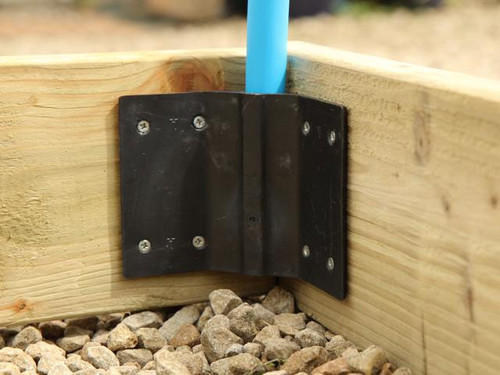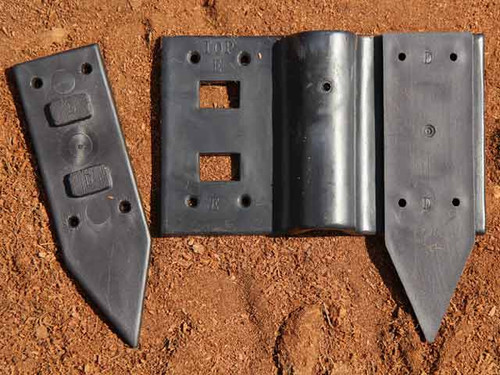Our hoop bed system includes custom made injection moulded plastic brackets for joining raised bed corners and joining boards to extend beds. The brackets are designed to fit 25mm flexible pipe which can be easily slotted in to form crop protection hoops over the top of your beds. Hoop beds can be used to make a warm mini polytunnel environment, for protecting from wind or cold temperatures and keeping out damaging insects like carrot root fly, cabbage root fly and cabbage white butterflies. As more and more harmful pest control products are removed from the market for environmental reasons the only option is to keep pests out using easy to construct protective environments like our hoop bed system.
The Quickcrop hoop bed system is a versatile and easy to use method for creating covered raised vegetable beds. The hoops can be added or removed when required and can be used to support polytunnel polythene, 'Enviromesh' insect protection mesh, horticultural fleece and butterfly and bird netting.
Spec : The brackets are 12cm deep and 10cm wide on each side
-
5 Hoop bed corner bracket
Easy to install and more than strong enough to support the hoops
Questions & Answers
Popular Questions
If so, given the area involved, would 2 bags do the trick for an initial feed, followed by annual dosing therafter?
Thanks! See more »
To be honest if you have stripped the soil back to that extent you really need to build new soil up and Liquid feeds or seafeed is not the right thing. These feeds are for existing soil to build the nutrients in the soil to feed your plants but as they are not a bulking agent they won't add much volume to the area which is what you need. I am afraid your suggestion of composted bark and manure plus topsoil is your best option but as you say will be expensive
Niall
Quickcrop See full answer »
The site is on sand (both topsoil and subsoil) and the turf has been neglected. An external contractor has been responsible for cutting the grass since the playing field was resurfaced several years ago, resulting in compaction and generally unhealthy turf.
As the playing field doesn't need particularly high quality turf but the site owner would like healthy turf all year, I initially plan to aerate (probably using a towed slit aerator as a result of budget and time constraints), and then feed and overseed at an appropriate time (hopefully soon, but possibly when the weather conditions are right early next year). Ongoing site maintenance would follow the same basic See more »
It is very loose and may travel through the mechanical system you are using to easily and as a result to much might be applied over a smaller area. It may be best to get a small amount first and try it. The product itself is perfect for what you are looking to do it is just whether it will work with your applier
Niall
Quickcrop See full answer »
That is fine. The seaweed meal is essentially for building plants immune systems and helping feed and look after plant health. The Seafeed is more of a slow release to feed the roots of the plant. If you have ground that you want to look after over winter and make sure it is in great shape in the Spring now is the time to put down the meal. If you have soil with plants in it over winter then i would use the Seafeed. I hope this helps
Niall
Quickcrop See full answer »
Seaweed Meal is not really an NPK feed so it is low in NPK. Something like 2/0.5/0.5 as it is more as a soil improver and for boosting the plants system and improving overall growth. For a higher NPK you would be better using the Seafeed mix of meal and organic chicken manure
Niall
Quickcrop See full answer »
I wouldn't go to heavy with it. 2/3 handfulls per square metre
Niall
Quickcrop See full answer »
The NPK of Seaweed meal is almost negligable as it is more a soil improver than a plant tonic. It has a very low NPK
Niall
Quickcrop See full answer »
The Seaweed meal is excellent but it sounds more like you need a slow release fertiliser so i would recommend from the same family Seafeed Organic manure pellets which are actually the Seaweed meal mixed with Organic chicken manure in pellet form. This product is applied at a rate of roughly 1 handful per square metre and will wash down gradually through the soil and is excellent for bringing on areas where the soil and plants need a boost
Regards
Niall
Quickcrop See full answer »













